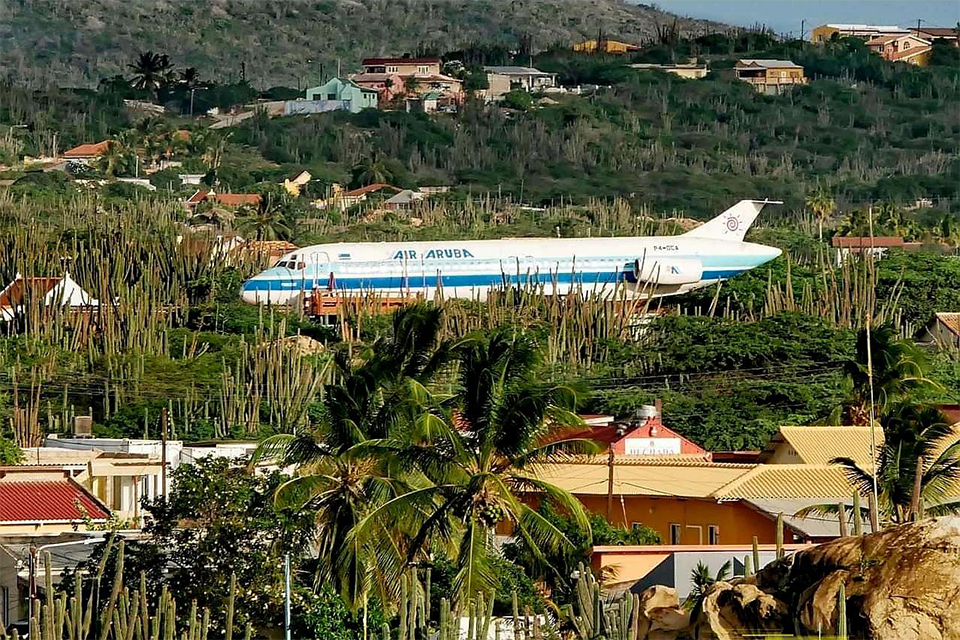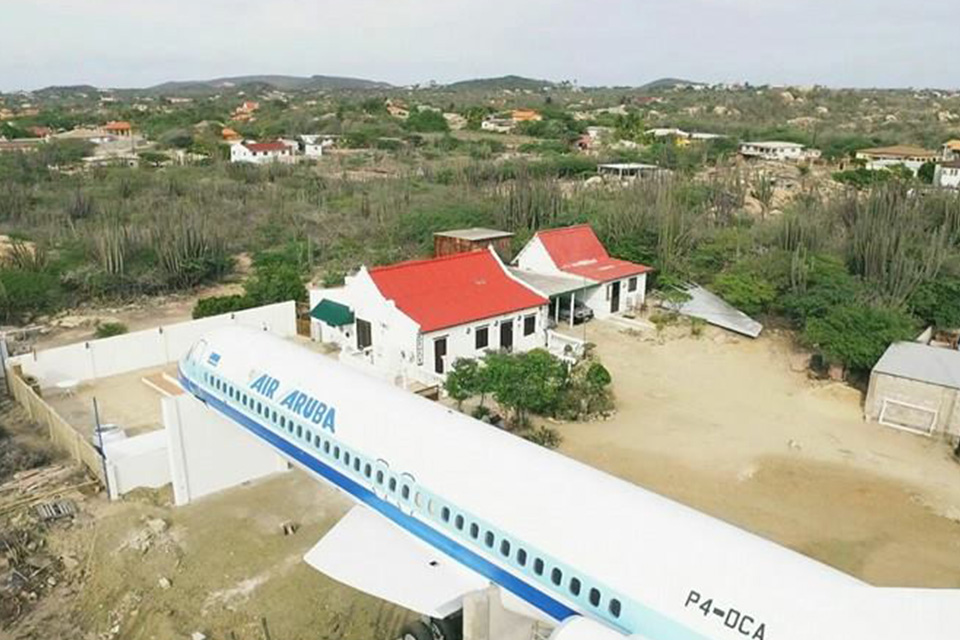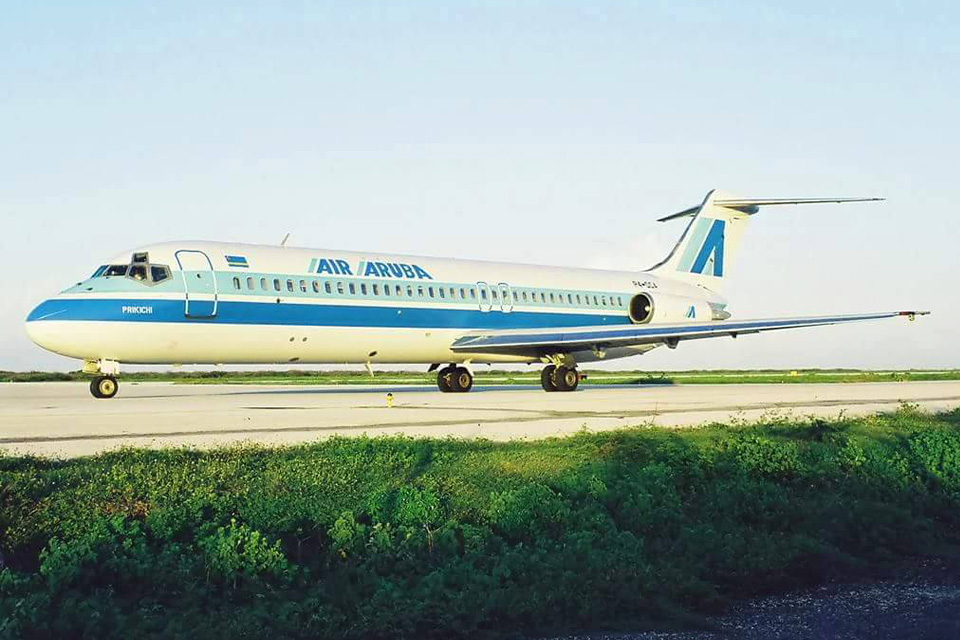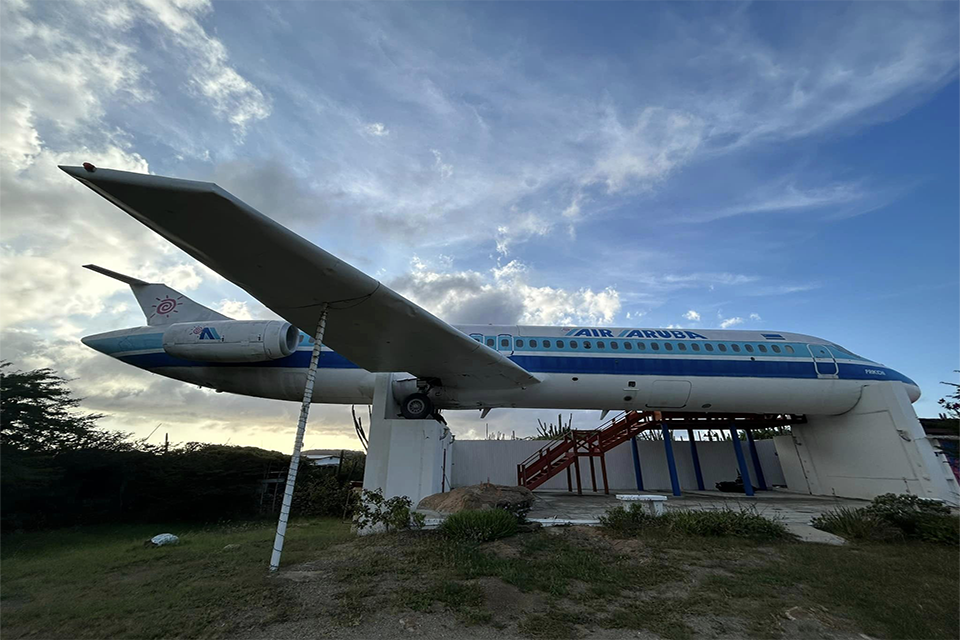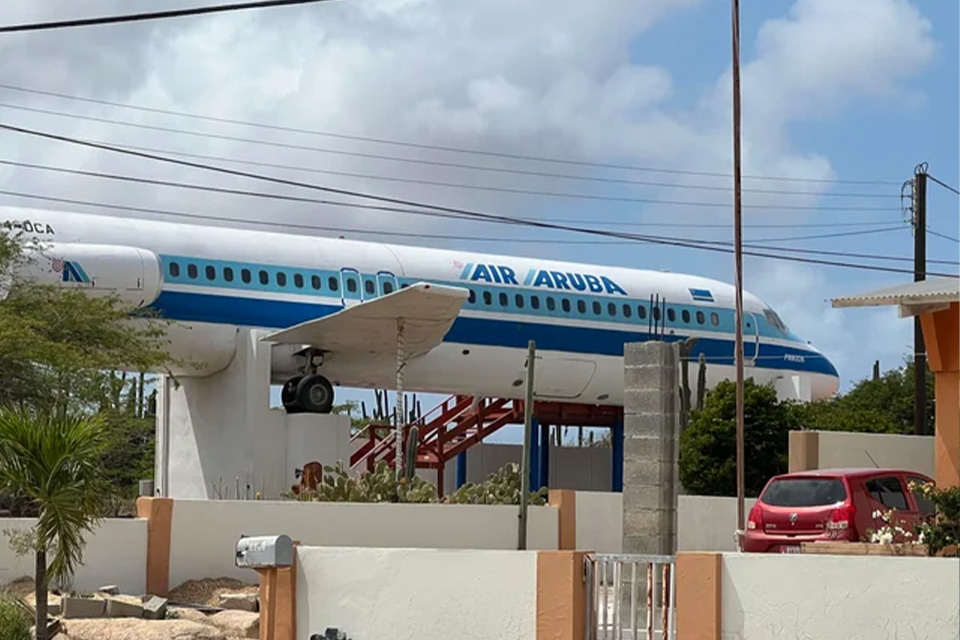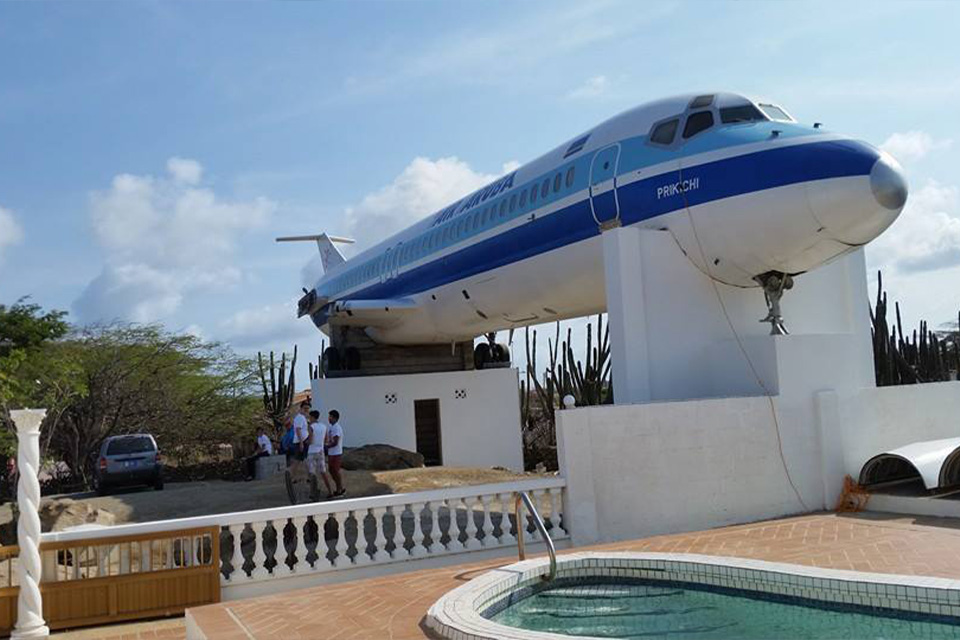While planning a trip to Aruba promises sun-soaked beaches and vibrant culture, imagine adding a touch of enigmatic aviation history to your itinerary. Nestled near Santa Cruz, Aruba, the DC9 Zone Air Aruba emerges as a compelling attraction for travelers seeking an extraordinary experience. The sight of a partially restored DC-9 aircraft on the hilltop sparks curiosity and intrigue, inviting visitors to delve into its untold story and the secrets it holds about Aruba’s past. After exploring the allure of DC9 Zone Air Aruba, where panoramic views of Aruba’s stunning landscapes await, unwind and recharge at Casiola Aruba. Conveniently located amidst the island’s beauty, Casiola Aruba offers a perfect retreat for travelers seeking both relaxation and adventure.
A hidden gem in Santa Cruz Aruba
In the serene hills of Santa Cruz, Aruba, a curious project awaits those who seek more than sun-soaked beaches and vibrant culture. It’s called DC9 Zone Air. An ambitious initiative aimed to transform an AirAruba’s last DC9 aircraft into a museum, restaurant, and social hub. But here’s the twist — the project started with grand plans but remains unfinished, leaving the airplane on the hilltop shrouded in mystery. Vacationers and locals alike have been intrigued by the airplane visible on the Santa Cruz hilltop. The presence of this aircraft has sparked curiosity and speculation, with many wondering about its origins and significance. This mystery adds an element of intrigue to the landscape, prompting travelers to inquire about its story and role in Aruba’s history. The airplane on the hill serves as a tantalizing glimpse into the island’s past, inviting visitors to delve deeper into its enigmatic presence.
Tracing AirAruba’s legacy
DC9 Zone Air stands as a testament to the legacy of AirAruba, a pivotal player in Aruba’s aviation industry. Founded with a vision to connect the island with the world, AirAruba operated for decades before retiring its fleet, marking the end of an era in Aruban aviation history. The decision to preserve and repurpose one of the last remaining aircraft, the DC9, reflects a deep commitment to honoring this legacy and sharing it with future generations.
AirAruba began its operations in the 1980s, serving as Aruba’s flagship airline during a period of significant growth in tourism and commerce. The airline played a crucial role in connecting Aruba to key destinations in the Caribbean, South America, and North America. Its fleet, which included various aircraft models, became synonymous with reliable service and a friendly, welcoming atmosphere, embodying the spirit of Aruban hospitality.
Over the years, AirAruba became beloved not only for its efficient operations but also for its cultural significance. The airline supported Aruba’s economy by facilitating tourism and trade, contributing to the island’s development as a premier Caribbean destination. For many Arubans, AirAruba represented more than just a mode of transportation; it symbolized pride in their island heritage and aspirations for a prosperous future.
As air travel evolved and new airlines emerged, AirAruba faced challenges that ultimately led to the decision to retire its fleet. The closure of AirAruba marked the end of an era but also sparked initiatives to preserve its legacy for future generations. DC9 Zone Air emerged as a visionary project to transform the final aircraft into a living museum, preserving artifacts, memories, and stories that define Aruba’s aviation history.
Restoration journey to Santa Cruz
The journey to Santa Cruz, where DC9 Zone Air rests, is a journey into both history and mystery. As visitors wind through Aruba’s picturesque landscapes, they can catch glimpses of the Caribbean Sea and lush, rolling hills that surround the island. This scenic route sets the stage for an immersive cultural experience, offering a blend of natural beauty and historical intrigue.
Ms. Dientje Hassell Henriquez’s envisioned DC9 Zone Air not just as a restoration project but as an immersive cultural experience. The restoration process involved preserving artifacts from AirAruba’s heyday, carefully refurbishing the aircraft’s interior, and designing interactive exhibits that tell the story of Aruba’s aviation evolution. From vintage uniforms to flight manuals and photographs, every detail aims to transport visitors back in time, offering a glimpse into the golden age of Caribbean air travel.
The journey of restoring DC9 Zone Air involved collaboration with aviation historians, preservation experts, and local artisans who contribute their skills to ensure authenticity and attention to detail. Every rivet, panel, and artifact is carefully curated to provide an immersive experience that captures the essence of AirAruba’s legacy and its impact on Aruba’s cultural identity.
Beyond aviation: cultural and culinary delights
What makes DC9 Zone Air special is its ambitious plan to go beyond its aviation roots. In addition to housing a museum and historical exhibits, the aircraft was set to become a vibrant social hub for locals and tourists alike. The fuselage will be transformed into a restaurant, where visitors can savor local cuisine with a view that’s truly unparalleled. Imagine dining under the wings of a historic DC9, surrounded by panoramic views of Aruba’s rugged terrain and azure waters — an experience promised to be as memorable as it is unique.
The social area within DC9 Zone Air was intended for community engagement, hosting events, cultural performances, and educational programs celebrating Aruba’s diverse heritage. Whether you’re a history enthusiast eager to delve into aviation archives or a food lover eager to sample traditional Aruban dishes, DC9 Zone Air promised something for everyone.
Ms. Dientje Hassell Henriquez envisioned DC9 Zone Air as more than a static museum; it had to become a dynamic space where visitors could immerse themselves in Aruba’s culture, connect with fellow travelers, and create lasting memories. The restaurant within the aircraft would showcase Aruban culinary delights, highlighting fresh seafood, Caribbean spices, and locally sourced ingredients that reflect the island’s vibrant culinary scene.
Anticipation and reflections
Despite its anticipated opening in late summer 2017, DC9 Zone Air remains unfinished, shrouded in mystery and anticipation. The airplane on the Santa Cruz hilltop continues to intrigue, offering a glimpse into Aruba’s aviation history and sparking curiosity about its future.
As Aruba eagerly anticipates the eventual unveiling of DC9 Zone Air, the project symbolizes the island’s commitment to innovation and preservation. It promises to be a milestone event in Aruba’s tourism industry, attracting enthusiasts and adventurers from around the world. DC9 Zone Air is not merely a restoration project, it’s a testament to Aruba’s enduring spirit and dedication to honoring its heritage in ways that captivate and inspire.
Planning your journey
While the accessibility of the DC9 Zone Air site for visitors remains uncertain, there’s plenty to explore and enjoy in Santa Cruz, Aruba. Nestled amidst scenic landscapes, Santa Cruz offers a variety of attractions and activities to complement your visit. From pristine beaches and winding hiking trails to flavorful local cuisine and rich cultural landmarks, Santa Cruz provides an ideal blend of relaxation and adventure.
Exploring nearby beaches allows for tranquil moments by the azure waters, while hiking trails offer opportunities to discover Aruba’s natural beauty and breathtaking vistas. Don’t miss the chance to immerse yourself in the island’s culture by sampling local dishes and visiting historical landmarks that dot the landscape.
Staying with Casiola Aruba
Although DC9 Zone Air’s doors never opened as originally planned, its legacy persists as a symbol of Aruba’s commitment to preserving its history and culture. The project, albeit unfinished, sparks curiosity and serves as a reminder of the island’s vibrant aviation heritage. Whether you’re drawn to its historical significance, culinary ambitions, or community spirit, DC9 Zone Air invites you to reflect on Aruba’s past while embracing its future possibilities.
As you plan your trip to Aruba, embrace the thrill of discovery and the allure of the Caribbean with DC9 Zone Air Aruba and Casiola Aruba. Start planning your adventure today and uncover the hidden stories that shape this vibrant island paradise.
-
Luxurious 5BR Villa with Stunning Pool! Kids Playground! 3min to Beach!
Villa - Tierra del Sol - Aruba
Welcome to a slice of paradise in Aruba, a grand, luxurious villa where every detail has been crafted to create an unforgettable experience. As you approach, a sweeping driveway leads you in, setting the stage for the stunning property that awaits. Just beyond lies a sparkling oasis, a large pool with an attached lap pool, that invites you to dive in or relax at your leisure. Surrounding the water are plush lounge chairs, perfect for unwinding in the warm tropical evenings. An outdoor shower offers a refreshing rinse after a swim, and for culinary delights, the BBQ grill is set up for festive al fresco dining. Little ones can revel in their own adventure on the playground, complete with swings, a slide, and climbing structures that keep young spirits entertained. Best of all, this villa is just a three-minute drive from Aruba’s pristine beaches, so you can easily soak up the sun, sand, and sea at any moment. Step inside, and you’re greeted by a fully equipped kitchen that any chef would admire. With modern, stainless steel appliances, a breakfast bar, and a JURA 8 Coffee Machine, it’s the perfect space for whipping up home-cooked meals with family and friends. Adjacent to the kitchen is a spacious dining table, ready for shared meals and conversations that last well into the night. The living room is a masterpiece of design, with high ceilings, and a large smart TV that makes it as cozy as it is luxurious—a place to gather, relax, and make memories. Each of the five bedrooms is its own private retreat. The main suite is pure indulgence, with a king-size bed, a private balcony that boasts a cozy lounge area with a view of Arashi Beach, and an en-suite bathroom. It offers a soaking tub, a walk-in shower, two vanities, and even two toilets for added convenience. The second bedroom features a queen bed and opens up to its own balcony through glass doors, where you can enjoy quiet mornings and sunset views. With a wall-mounted smart TV and an en-suite bathroom that includes both a bathtub and a walk-in shower, it’s a haven of comfort. In the third bedroom, you’ll find a king bed, a smart TV, and another private bathroom, complete with a walk-in shower. The fourth bedroom boasts yet another private balcony with a lovely lounge area and stunning views, offering a serene space to unwind. A queen bed, smart TV, and a luxurious bathroom with a walk-in shower make it a perfect escape within this paradise. Bedroom five, designed with flexibility in mind, features both a full-size and a twin bed, ideal for families or friends sharing a room. This room also comes with a private bathroom and a walk-in shower. To add to the villa’s practicality, a laundry room is equipped with both a washer and dryer, making it easy to keep everything fresh and ready. Every corner of this home whispers luxury and comfort, whether you’re spending the day lounging by the pool, cooking up a feast, or retreating to your private suite for some quiet relaxation. This is more than a place to stay; it’s a place to truly unwind, indulge, and make memories that will linger long after your visit to Aruba comes to an end. Located in Tierra del Sol gated community. Tierra Del Sol resort is the premier vacation rental resort in Aruba. A luxurious environment with a 600-acre, 71 par, 18 hole golf course, tennis courts, a Premium Casual Dining Experience in the resort restaurant, which also offers delivery, and state-of-the-art wellness at The Spa. Casiola manages several top-of-the-line vacation rentals in this resort. NOTE: Access to the Tierra del Sol resort swimming pools and amenities is not included with this rental. However, activities and day passes can be booked directly at the resort. NOTE: The Tierra del Sol golf course is currently undergoing renovation and is temporarily closed for play. -Property Notes- UTILITIES: All utilities are INCLUDED. (Keep this in mind when comparing rentals as this cost is most often not included). TAXES: The following mandatory taxes are included: - Government Tax: 12.5% - Environmental Tax (as per Aruba tax code): $3 per night Taxes may be subject to change. CHECK-IN/ CHECK-OUT: Check-in time is 4:00 PM. Check-out time is 11:00 AM. Earlier check-ins and later check-out can be requested 24 hours before and will be granted depending on availability. A surcharge may apply. HOUSEKEEPING: This is a self catering vacation home and as such you are expected to do your own shopping and regular cleaning. We do offer the option of daily or mid-stay, hotel-style cleaning services. This is an extra service and a surcharge applies. Start-up supplies are provided and will be restocked if you request our optional daily or mid-stay hotel-style cleaning service. We provide 1 set bath linen per person max occupancy; extra sets are available at a surcharge. BEACH ESSENTIALS: We provide beach chairs (6), beach towels and a cooler. We do not provide snorkeling equipment or umbrellas. CONCIERGE SERVICE: Our Guest Relations Team can assist with making arrangements for transportation, private chefs, yachts, and other vacation activities. CAMERA(S): This home has a camera outside at the front of the home with a view of the entrance and street.- 11
- 5
- 5.5
from
$351/night -
Deal
Ocean View! Condo right on the strip in Palm Beach
Condo - The Cove Condominium - Aruba
Location is everything! So, get yourself in the center of the action by staying at this hip-to-the-minute 2 Bedroom/2 Bathroom condo, located directly on the high-rise strip! That’s right, you can enjoy an endless array of shops, dining, cinema, and more… right at your fingertips! Every inch of this five-star getaway is stunning, as each room offers a breathtaking view of swaying palms and glistening city lights! Elegant touches of chic decor and beach-dweller ornamentation are displayed throughout the house, adding fun and festive variety to this opulent stay. The kitchen is complete, showcasing contemporary cabinetry, a marble backsplash, and stainless-steel appliances. Staged with five black stools, the kitchen island doubles as a breakfast nook, exquisitely complimenting the white backdrop of the kitchen. This galley has everything you need to make mealtime a breeze. But if you’re looking to make your early morning cup of joe a little extra special, you’ll find a Starbucks just across the street! The family room is sleek and efficient, offering a midcentury modern low-profile couch, accompanied by a stylish coffee table, additional guest seating, a flat-screen television, and one contemporary floating entertainment center. Lastly, the area rug provides a subtle yet effective pop of color, contrasting the rustic flooring perfectly. Step outside and take a moment to take in beauty that surrounds you. Here, you will find you can kick off each day with a breath of fresh air! Or end each evening by reminiscing about your latest adventure. Are you ready to unpack and unwind in style? Bedroom #1 presents a King size bed with a trendy headboard, pristine white night tables, a matching dresser, cozy guest sweating, a wall-mounted flat-screen television, and an oceanic-inspired area rug. Bedroom #2 hosts a Queen size bed, matching night table, a fashionable dresser, and a wall-mounted flat-screen television. Both bathrooms feature white subway tile, a double-wide vanity, unique cutout view, and a deluxe stall glass walk-in shower with tiled flooring. This tranquil setting is sure to help you relax and gear up for the night ahead. Convenience is key when it’s your vacation! Parking is free and easy on the Cove parking lot with a key card. In addition, you’ll find beach chairs, as well as a cooler to bring to the beach! And did we mention – your home is located right above one of the hippest restaurants in town? Talk about convenient! Searching for some fun? Head off to the Paseo Herencia Shopping Mall and Palm Beach Plaza Shopping Mall, located right across street. And don’t forget to hit the beach, just walking distance from your condo! With the Moomba Beach Club at 100 yards you can lounge under one of their palapas and get served cold drinks enjoying live music! With a location like this, you just can’t beat it! The Cove Condominiums are located directly on the strip! The Cove is one of the hottest spots in all Aruba! Stay in the heart of the action where a bustling nightlife comes to life amidst an array of lavish casinos, delicious eateries, themed entertainment, and high-end shopping malls! As if that weren't enough, this high-rise is just a short stroll to one of the Top 10 Beaches in the World… the one and only Eagle Beach. This award-winning location exceeds all expectations, showcasing soft white sand, crystal clear turquoise water, and a constant warm breeze. When it comes to these condominiums, luxury makes its way center stage. Featuring opulent options from head to two, this unique dwelling features its very own rooftop bar above and tantalizing restaurants below. The unique design of each condo holds an open concept, chic style, fine furnishings, spacious dimensions, plenty of natural light, and breathtaking views. Let this five-star getaway of swaying palms and glistening city lights be yours. So, pack your bags and get yourself on a plane because 'The Cove' is ready to make your one-of-a-kind vacation dreams come true! So, pack your bags and get yourself on a plane because The Cove is ready to make your one-of-a-kind vacation dreams come true! DISCLAIMER: Please note that there is ongoing demolition work at the back of the building, starting Monday, November 18th, and continuing until Monday, December 16th. The work will take place on the ground floor and may result in significant noise from 10:00 AM to 5:00 PM, Monday through Saturday. -Property Notes- UTILITIES: All utilities are INCLUDED. (Keep this in mind when comparing rentals as this cost is most often not included). TAXES: The following mandatory taxes are included: - Government Tax: 12.5% - Environmental Tax (as per Aruba tax code): $3 per night Taxes may be subject to change. CHECK-IN/ CHECK-OUT: Check-in time is 4:00 PM. Check-out time is 11:00 AM. Earlier check-ins and later check-out can be requested 24 hours before and will be granted depending on availability. A surcharge may apply. HOUSEKEEPING: This is a self catering vacation home and as such you are expected to do your own shopping and regular cleaning. We do offer the option of daily or mid-stay, hotel-style cleaning services. This is an extra service and a surcharge applies. Start-up supplies are provided and will be restocked if you request our optional daily or mid-stay hotel-style cleaning service. We provide 1 set bath linen per person max occupancy; extra sets are available at a surcharge. BEACH ESSENTIALS: We provide beach chairs (6), beach towels and a cooler. We do not provide snorkeling equipment or umbrellas. CONCIERGE SERVICE: Our Guest Relations Team can assist with making arrangements for transportation, private chefs, yachts, and other vacation activities. CAMERA(S): This home has a camera outside at the front of the home with a view of the entrance and street.- 4
- 2
- 2
from
$189/night -
Oceanfront Villa - Sunset view - Sauna - Game Room
Villa - Aruba
Step into a mansion with spectaculair ocean and sunset views that was built to make your dreams come true! Whether you’re planning a full family reunion or the poolside party of a lifetime, this island getaway is ready to play! Brimming with a robust collection of amenities, this massive Oceanview Vacation Home packs a real punch! Not only is there a primary residence, but 2 additional townhouses located in the back, as well. Making for a grand total of 8 Bedrooms! Located in the main house are Bedroom #1 and Bedroom #2, both of which offer private spa-worthy en suites that provide a calm and relaxing escape. Bedroom #1 showcases spectaculair ocean and sunset views, a plush King size bed set against a vibrant terra cotta-colored accent wall. Framed beautifully by a large window, this room allows for plenty of natural sunlight. The attached bathroom is luxurious and chic, featuring hanging mirrors above the double sinks overlooking the ocean and a spacious walk in shower. Bedroom #2 highlights a King size bed with a rich royal blue headboard, which stunningly contrasts against a light blue accent wall. Beneath sits an ornate area rug, as a pair of matching night dressers offer extra room to unpack and unwind. Bedroom #3, located in the main house, features a luxurious King bed, a private en suite bathroom, and a cozy seating area with an incredible ocean view — perfect for enjoying a quiet moment. Inside the poolside apartment reside Bedroom #4, Bedroom #5, Bedroom #6, and Bedroom #7, all of which come with their own charm, as well as two additional half baths. Bedroom #4 features a double bed (full) and contains a jack-and-jill door to the common area, making it an ultra-convenient location! Both Bedroom #5 and Bedroom #6 highlight king-size beds and their own private en suites. Bedroom #7 offers a bit of versatility, presenting 2 single beds, as well as its own private en suite. Looking to get the best of both worlds? Bedroom #8 is a poolside room that remains attached to the main house. This boudoir is set with a King bed, its very own attached bathroom, and a cozy seating area, overlooking the stunning ocean view. Featuring terracotta roofing, stately white columns, and an oasis of tropical landscaping, this façade is nothing short of breathtaking! From the moment you arrive, you just know your stay is going to be a memory that lasts a lifetime. Inside, sleek tiled flooring, high vaulted ceilings, and a wide-open concept set the stage for a bevy of fine furnishings and decorative décor that provide plenty of room to unpack, unwind, and turn this house into a home! Enjoy some of that indoor/outdoor living, as a series of tall glass windows line the front of the house, providing an abundance of natural sunlight! The recently renovated, modern kitchen is stocked with everything you need to make a home-cooked meal. Conveniently located just a few feet away is the banquet area, showcasing a handsome dark wood supper table and modern dining room seating. The family room offers a pristine white sectional with a built-in chaise lounge, guest chairs, and matching ottomans, as island-inspired woven pendant lights illuminate the space from above. Vacation is meant to be carefree! So, what better way to amp up the fun than to show off your skills than in the Game Room! Whether you’re an air hockey champ, a card shark, or the best at billiards, an endless array of options is right at your fingertips! Naturally, you’re not traveling to this happy island without a little tropical fun in the sun, right? Step outside onto your very own private veranda where true paradise awaits. Here, you’ll discover a deluxe sauna, as well as a jacuzzi that can accommodate up to eight people! Bask in the warm breeze and lie beside the shade of the palms, as you lounge with a drink in your hand. Whether you’re taking a cool midday dip, dining alfresco under the stars, or heating things up beneath the moonlight – there is no better place to be! The pool area has been newly renovated with fresh tiles, while the garden has been renewed, bringing a vibrant and lush backdrop to your outdoor experience. Whether you’re lounging poolside or dining under the stars, the setting is perfect for making lasting memories. If you’re looking for something a bit scenic and romantic, be sure to stay on the patio during sunset. This prime location is the idyllic place to watch! One of the more impressive things about this home is its location. Straight across from the water and close to the beaches, you won’t even feel the need to leave the premises once you arrive. If you ever wanted to know how it would be to be the King of your own little island, this is your chance! -Property Notes- UTILITIES: All utilities are INCLUDED. (Keep this in mind when comparing rentals as this cost is most often not included). TAXES: The following mandatory taxes are included: - Government Tax: 12.5% - Environmental Tax (as per Aruba tax code): $3 per night Taxes may be subject to change. CHECK-IN/ CHECK-OUT: Check-in time is 4:00 PM. Check-out time is 11:00 AM. Earlier check-ins and later check-out can be requested 24 hours before and will be granted depending on availability. A surcharge may apply. HOUSEKEEPING: This is a self catering vacation home and as such you are expected to do your own shopping and regular cleaning. We do offer the option of daily or mid-stay, hotel-style cleaning services. This is an extra service and a surcharge applies. Start-up supplies are provided and will be restocked if you request our optional daily or mid-stay hotel-style cleaning service. We provide 1 set bath linen per person max occupancy; extra sets are available at a surcharge. BEACH ESSENTIALS: We provide beach chairs (6), beach towels and a cooler. We do not provide snorkeling equipment or umbrellas. CONCIERGE SERVICE: Our Guest Relations Team can assist with making arrangements for transportation, private chefs, yachts, and other vacation activities. CAMERA(S): This home has a camera outside at the front of the home with a view of the entrance and street.- 18
- 8
- 8.5
from
$820/night -
Beautiful Tierra del Sol home w/ private pool + GREAT amenities
House - Tierra del Sol - Aruba
Come experience luxury at this 3 Bedroom, 3.5 Bath Villa! - Casa del Sol is a beautifully decorated and climate-controlled home featuring 3 Bedrooms with their own en-suite. The kitchen is equipped with everything you need to whip up a family favorite recipe, including stunning, high-end appliances, tiled backsplash, and a Nespresso machine, for the caffeine-addict in your crew! Enjoy a nice quiet meal in the banquet area, featuring a sleek mid-century modern supper table, on-trend dining chairs, and an unforgettable view! The ultra-comfortable living room is located in the center of the home, showcasing an open concept with immaculate views of the garden and pool area. Offering seating for 6, this is the ideal place to kick back, relax, socialize, or reconnect with family. If you're in the mood to browse Netflix, take advantage of the flat-screen television provided for your entertainment pleasure. Bedroom #1 is the Master Bedroom, featuring a Queen bed, wooden dresser with/mirror, and a flat-screen television. In addition, you will uncover a private en- suite bathroom with a classic vanity, walk-in shower, and luxurious soaker tub. Bedroom #2 offers a queen bed with an elegant feminine charm, including delicate furnishings, drapery, artwork, and more. This graceful boudoir also presents a private en-suite bathroom with a walk-in shower. Bedroom #3 embodies a sophisticated grace, presenting a queen size bed, streamlined tray night stands, and matching adornments with pops of color. This stylish dorm also comes equipped with a private en-suite bathroom with a chic glass stall shower. If you hate to pack, you’re not alone! That is why a Laundry Room is provided with a stacked washer dryer. The patio and pool area will have you feeling like you’re in a high-end resort! Around every well-manicured bend you will find additions that continue to impress, including a covered with pergola, chic patio set, BBQ grill, lounge chairs, and a pool with swim-up bench. The garden and covered patio are perfect for entertaining and provide direct access to the resort-style pool which showcases a swim up bench! There is nothing not to love here! But don’t take our word for it! Come and experience “the good life” for yourself! Tierra Del Sol resort is the premier vacation rental resort in Aruba. A luxurious environment with a 600-acre, 71 par, 18 hole golf course, tennis courts, a Premium Casual Dining Experience in the resort restaurant, which offers delivery, and state-of-the-art wellness at The Spa. NOTE: Access to the Tierra del Sol resort swimming pools and amenities is not included with this rental. However, activities and day passes can be booked directly at the resort. NOTE: The Tierra del Sol golf course is currently undergoing renovation and is temporarily closed for play. -Property Notes- UTILITIES: All utilities are INCLUDED. (Keep this in mind when comparing rentals as this cost is most often not included). TAXES: The following mandatory taxes are included: - Government Tax: 12.5% - Environmental Tax (as per Aruba tax code): $3 per night Taxes may be subject to change. CHECK-IN/ CHECK-OUT: Check-in time is 4:00 PM. Check-out time is 11:00 AM. Earlier check-ins and later check-out can be requested 24 hours before and will be granted depending on availability. A surcharge may apply. HOUSEKEEPING: This is a self catering vacation home and as such you are expected to do your own shopping and regular cleaning. We do offer the option of daily or mid-stay, hotel-style cleaning services. This is an extra service and a surcharge applies. Start-up supplies are provided and will be restocked if you request our optional daily or mid-stay hotel-style cleaning service. We provide 1 set bath linen per person max occupancy; extra sets are available at a surcharge. BEACH ESSENTIALS: We provide beach chairs (6), beach towels and a cooler. We do not provide snorkeling equipment or umbrellas. CONCIERGE SERVICE: Our Guest Relations Team can assist with making arrangements for transportation, private chefs, yachts, and other vacation activities. CAMERA(S): This home has a camera outside at the front of the home with a view of the entrance and street. NOISE MONITOR: This home has a noise monitoring system outside by the pool area.- 6
- 3
- 3.5
from
$152/night
4 of 108 properties
FAQs
What are the historical or investigative background details about how the airplane ended up on the hilltop in Santa Cruz?
To address the historical and investigative background of the airplane on the hilltop in Santa Cruz, it’s essential to delve into the local records and historical accounts related to the site. The airplane’s presence on the hilltop likely has a complex history involving either a past crash or a strategic placement. Investigations might have revealed details about the aircraft’s origin, the circumstances leading to its placement on the hilltop, and any relevant historical events or accidents associated with it.
Are there any local legends, folklore, or community theories related to the airplane’s presence on the hilltop?
Local legends and community theories often add a layer of intrigue to such mysteries. In Santa Cruz, there may be various folklore or stories about the airplane, possibly involving tales of it being a forgotten relic of an old aviation incident or part of local myths about unexplained occurrences. These legends can sometimes influence public perception and contribute to the mystique surrounding the airplane.
What actions, if any, have been taken by local authorities or aviation experts to further investigate or preserve the site?
Regarding actions taken by local authorities or aviation experts, they may have conducted investigations or preservation efforts to understand the airplane’s history and ensure its safety. Authorities might have examined the site to prevent unauthorized access or deterioration, while aviation experts could have been involved in assessing the aircraft’s condition and historical significance. These efforts help clarify the airplane’s story and maintain the site’s integrity for future generations.

